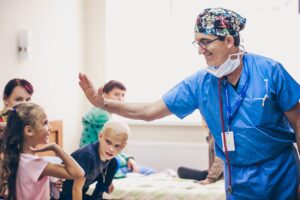Boston physician Dr. Gennadiy Fuzaylov is on a mission to help the war-wounded children of Ukraine access vital medical care — even if he has to bring them across the ocean to do it.
“So far I have been able to bring five kids to the U.S.,” Dr. Fuzaylov, who works out of Massachusetts General Hospital and Shriner’s Hospital in Boston, tells PEOPLE.
It is, he believes, “the first effort to treat injured patients during the conflict,” as opposed to those with long-term conditions such as cancer.
“The kids came from Mariupol, Lviv, Kyiv and Mykolaiv, so four different cities,” Fuzaylov adds about his patients, who range in age from 1½ to 18 and have a mixture of domestic and war-related injuries, he says.

“One of them I was able to bring to a hospital in Augusta, Georgia, and four are here in our hospital in Massachusetts,” he says. “It is a very complicated evacuation path. Two of the children in our hospital were bombed on their way to the airport. Their car was bombed. They were terrified and just so glad to have finally reached the aircraft.”
Now that the children are in the U.S., “They feel safe, they feel taken care of,” says Fuzaylov. “They feel like God has taken them away from hell.”
Yet it’s not just the physical wounds of the patients that Fuzaylov and his team are having to treat.
As minors, the children have all traveled to the U.S. with their mothers to ensure they always have close family nearby. Having also lived through the horrors of Russia’s invasion of Ukraine, however, the moms need care of their own.

“So along with treating the kids we’re also providing comfort for mothers who have escaped the war and the bombing, and the ritual of having to get your family inside a shelter multiple times a day just to remain safe,” Fuzaylov explains.
Once the medical treatment is completed — Fuzaylov estimates it’ll take between one and four months for each patient, depending on the type and severity of the injury — the kids and their moms will return home to their families in Europe so they can rebuild their lives in countries such as Poland and Romania.
This level of support doesn’t come cheap, however: To facilitate the health care for the refugees, Fuzaylov has so far relied on the generosity of donors to pay the estimated $90,000 cost of flying a wounded child from Ukraine to the U.S.
For two children the cost is even higher, at up to $150,000 per flight, Fuzaylov says.
“It is a lot of money, but if they need medical assistance and are not stable then they need to be supervised by a physician and nurses,” he says. “A regular airline will not accept them either because of their medical condition.

“For instance, the kid I brought to Georgia was successfully airlifted with a blast injury from Mariupol. He had multiple fixators on his extremities, so they were not able to fit him in a small aircraft,” Fuzaylov says. “Basically, his fixators were too big, so we couldn’t just put him on a regular stretcher.”
To continue this work of helping children who can’t currently access medical care, Fuzaylov now hopes to create a network of hospitals across the U.S. that can provide vital treatment.
He’s also aiming to extend the reach of the non-profit Doctors Collaborating to Help Children, which he co-founded in 2005 when a young Ukrainian girl came to Shriners Hospital for treatment on burn injuries she sustained in a fire while saving her younger sister.
Since then, the DCTOHC has coordinated the treatment of multiple child burn victims both in the Ukraine and the U.S., with Fuzaylov most recently visiting the country in February 2022, just before the Russians launched their invasion.
As with his most recent initiative, the injured kids all receive treatment in the U.S. free of charge.
At the same time Dr. Fuzaylov is also motivated to help because he believes Ukraine is now on the cusp of a major health crisis created by the combination of widespread injuries and a devastated healthcare system, he says.

“I don’t know where the kids in Ukraine currently get treated, because the Ukrainians do not have the capacity at the moment to develop a full picture of what’s going on,” he says. “There are not a lot of sick or injured Ukrainian kids following the refugee paths to Germany, Poland and the Czech Republic. But after 71 days of war there should be far, far more.”
That alone is a worrying sign.
“Kids are currently living in the occupied or blocked areas, and as soon as these areas are unblocked there will be a huge flow of injured and sick children needing help,” Fuzaylov says. “We hope that more hospitals will participate in helping them because it’s going to be a huge crisis with tens of thousands of patients of all ages needing care.
“I know the resources are strained everywhere but hopefully more hospitals and physicians will be able to help,” he adds. “People need to see the hope and these kids need help.”
The Russian attack on Ukraine is an evolving story, with information changing quickly. Follow PEOPLE’s complete coverage of the war here, including stories from citizens on the ground and ways to help.